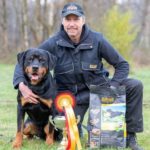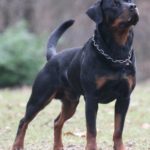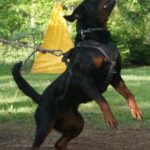Rottweilers have historically been considered a versatile working breed; one capable of performing admirably within a number of disciplines in the K9 world. The modern era (my personal definition) post 2000 has seen an unofficial delineation between “working line” and “conformation/show” line rottweilers. The latter, generally being a heavier set, larger type version and working lines being slightly smaller more agile specimens.
The other significant difference is the temperament/character or drives that are present in each segment of the breed; working line rottweilers seem as a general rule to be more energetic, driven and possess higher levels of prey and aggression drives than their show line counterparts. Obviously there will be specimens within each segment that mimic the other but that is the exception more than the norm….
There is a definite swing in terms of the public’s taste towards the easier to manage show line rottweiler, however the taste for the original hard working rottweiler is still present among a smaller group of “working” enthusiasts, and one of the platforms in which this is exhibited is the ADRK DM; this is the domain of the working rottweiler!
The DM is the annual competition for German bred rottweilers, whose owners are members of the ADRK where the German Working Champion is determined. Those dogs competing in the DM must qualify to do so via a regional competition; so the DM is comprised of the best working rottweilers in Germany.
The following article is a high level overview of the DM for the decade 2008 – 2018.
Hopefully it will give you a flavour of the significance of the event and the importance of the dogs competing in it, and particularly those which excel in this competition.
How many dogs participate in the DM?
The average number of participants in the last 10 yrs. is approx. (36), Dependent on the year it has been as low as (24) in 2018, or as high as (45) 2015.
The disparity in numbers by year make it difficult to draw a conclusion on the trend of participation rates, however the graphical representation of the last 10 yrs. indicates a downward trend – most would agree that this is in line with the increased popularity of the “conformation / show” lines vs the working line Rottweiler in the modern era; (in saying this we must mention that to draw a definitive conclusion we would need to compare the data from previous decades.)

How many participants achieve a passing score?
The average no of times that passing scores were registered over the last 10 yrs is 77%.
The negative flip side is that each time somebody enters the DM there is roughly a 1:5 chance they will fail!
The DM is a difficult competition, firstly to qualify and then to excel and achieve a good outcome!
The best year was 2013 with a 96% pass rate, and the worst was 2017 with 65%.

Passing scores like participation rates in general are trending down.
This in itself would be a worrying trend, however it is softened a little by the fact that both participation & passing scores seem to be relative to each other (see the graph below) – the results confirm that the interest in “working rottweilers” is on the downward trend, however it is encouraging that the quality of working rottweilers has not seemed to have diminished.

How many participants achieve the highest rating; “V”?
“V” scores are important! What are they?
The “V” score denotes “excellent” performances and that the dog/handler combination was able to be awarded 96% of the available scores for that routine. You can see the scoring table below:

Achieving the rating of “excellent” is a significant achievement – scoring 96% or above is difficult in all of lifes endeavours and this is certainly the case in IPO/IGP.
The degree of difficulty is increased significantly as compared to other sporting endeavours as the handler is not only managing their own input but they are also managing the K9!
Testament to this difficulty is the very low number of “V” scores achieved over the decade – the average is 1.7 times per tournament/year, with the best years in the decade occurring in 2012, 2013 with (4) “V” scores in each of those years and closely followed by 2014 with (3).
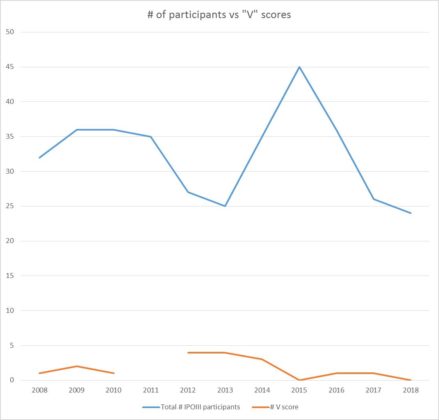
On (3) occasions there was no “V” scores recorded.
The next best after “V – excellent” is “SG – Very Good”. SG is awarded for those achieving between 90 – 95%.

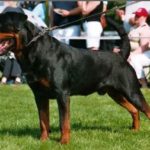
On average in the last decade (35%) participants achieved SG ratings or better; that’s 1 in 3 participants scoring in the top 10%, testament to the caliber of rottweilers presented for this prestigious competition every year.
The highest score recorded at the DM in the last decade is (292).
This occurred on (3) occasions; 2013 for the DM Champion Elch vom Heltorfer Forst and in 2009 for first place Ety vom Herrenholz and the same total for 2nd place Jack vom Markgraflerland (same overall score as winner but relegated to second due to lower protection score)
The best & not so best years
The best years; how do we define this? Most passes, highest score, most V scores, highest average scores and the list go on….
For this article we define best as the years that produced most of the coveted “V” scores.
2012 & 2013 each produced (4) “V” scores and 2014 produced (3). 2013 also produced the highest pass rate of the decade at (96%), although one of the lower participation rate with (25) participants.
Given the low participation rate, the equal highest number of “V” scores and the highest pass rate 2013 must be crowned “King of the decade”.
The podium finishes for that year were as follows:
• 1st Place – Elch vom Heltorfer Forst, (A100 B97 C95) Total 292
• 2nd Place – Amboss vom Norderdieck (A97 B95 C99) Total 291
• 3rd Place – Boss vom Kriegsdamm (A100 B90 C99) Total 289
All (3) place getters, as for all other years’ are exceptional working rottweilers.
It should also be noted that each of these (3) were also awarded Korung, Gekort B. Eza, which is lifetime qualification for the advanced breed suitability test – but that’s for another article!
Gender wars
Overall the trend for male participation is down and the females are up. Could it be that people recognise the importance of the female and are working more of them? Who knows?

The annual average number of male participants over the decade is 29.6 (83%) vs 6.1 (17%) females, it’s encouraging to report that like percentages make up the representation in podium finishes over the decade.
Although (15%) of podium spots were filled by females, the actual number of females in podium finishes is (3)! They are:
• Bambam von den Wichtelhausern (1st place 2015, 2016 & 3rd place 2017)
• Aki von den Wichtelhausern (2nd place 2016, behind her sister Bambam)
• Enya vom Kinzigtal (3rd place 2011)
I’m happy to report that Seeuferhause have these bloodlines well represented in the breeding program through Enya’s daughter Bluelady vom Checkpoint Charlie (Chilli) and Bambam’s brother Butch von den Wichtelhausern.
Battle of the generations
The average age for participants of the DM in the last decade range from 3.25 – 8.5 yrs.
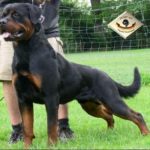

The average age of the winners is generally 5.5yrs, with notable exceptions being Ives vom Hause Neubrand II in 2008, winning at 3.5yrs and more recently, 2017 Onex vom Turnleberg winning at 3.5 yrs.
The oldest winner was Boss vom Kriegsdamm at 7.5yrs
At this point we must recognise the magnificent effort to not only have dogs titles to IPOIII, but qualify through regional events and then compete and win at 3.5 yrs of age – INCREDIBLE! And a testament to both handler, support team and most of all the dogs ability to achieve so much in such little time.
Most Successful Bloodline
It doesn’t take long before the conversation turns to which bloodline is the best producer of working dogs? For this discussion we will focus on paternal bloodline of the individual. Additionally we are evaluating the (33) podium spots available over the decade.
Specifically for the DM and the last decade the answer is simple – 60% of podium finishes can be traced back to Noris vom Gruntenblick. A massive testament for a dog that was born in 1988 and yet his influence reigns supreme.
The most popular avenue to Noris is descendants via Max vom Turnleberg (11 podium finishes) and Jackomo von der Bleichstrasse (7 podium finishes)
Noris is what I commonly refer to as a “pillar” of the breed; he is a dog that has influenced the breed significantly across a number of platforms: show winners / champions, successful breeding dogs, Korung titled dogs and of course working champions. There is a few dogs I consider “pillars” & “pillars” require recognition and future feature articles on our website will focus on them.

Achieving a podium finish in the DM is a challenging endeavour, let alone achieving multiple podium finishes – this has only been achieved by (7) dogs in the last decade – a notable mention for Bambam von den Wichtelhausern who achieved (3) podium finishes, back to back wins in 2015 & 2016 and then a 3rd place in 2017.
For those of us residing in Australia, you may better understand the difficulty associated with “podium” finishes to that of winning AFL Grand Finals. one is hard enough! back to back only a dream!! and a “threepeat” (3 in a row) mission impossible!!! Unless your name is Bambam von den Wichtelhausern or the Hawthorn Football club….
GO HAWKS!!!!
One of the more significant “podium finish” stories happens to be from the 2018 DM competition – the once “new” but now “renowned” working Rottweiler kennel “vom Tanneneck” occupied all (3) podium places with dogs from their kennel, and a fourth dog from the “G” litter (Gracy vom Tanneneck) placing 8th – that’s almost like being dealt a Royal Flush!!
- Gollum vom Tanneneck
- Faxe vom Tanneneck
- Gauner vom Tanneneck
A massive shout out and huge congratulations to Uwe & Kristen and their magnificent
vom Tanneneck Rottweilers!!!
And of course we have links to vom Tanneneck via our previous German import Clyde vom Tanneneck and will shortly have a direct link to the “G” vom Tanneneck litter via Giant, owned by our good friend Anu!
Hopefully this article provides a very small snippet of the research and work that goes into the selection of our breeding dogs here at Seeuferhause.
Reading through this post you will likely find some of the names familiar; this is because we have carefully selected very close relatives to the very dogs occupying the podium positions in this prestigious competition;
the “ADRK DM”.
I hope you enjoyed the article.
Cheers,









